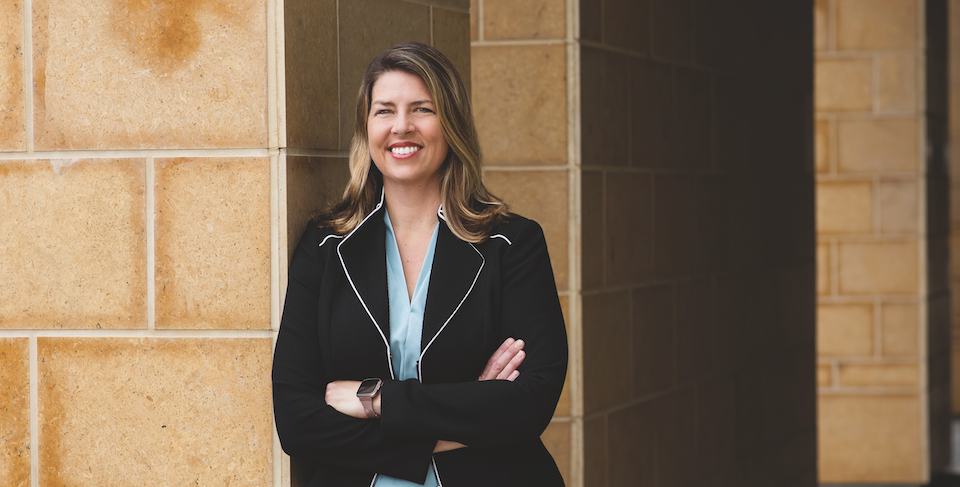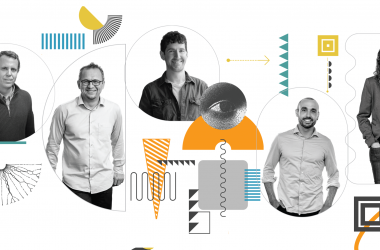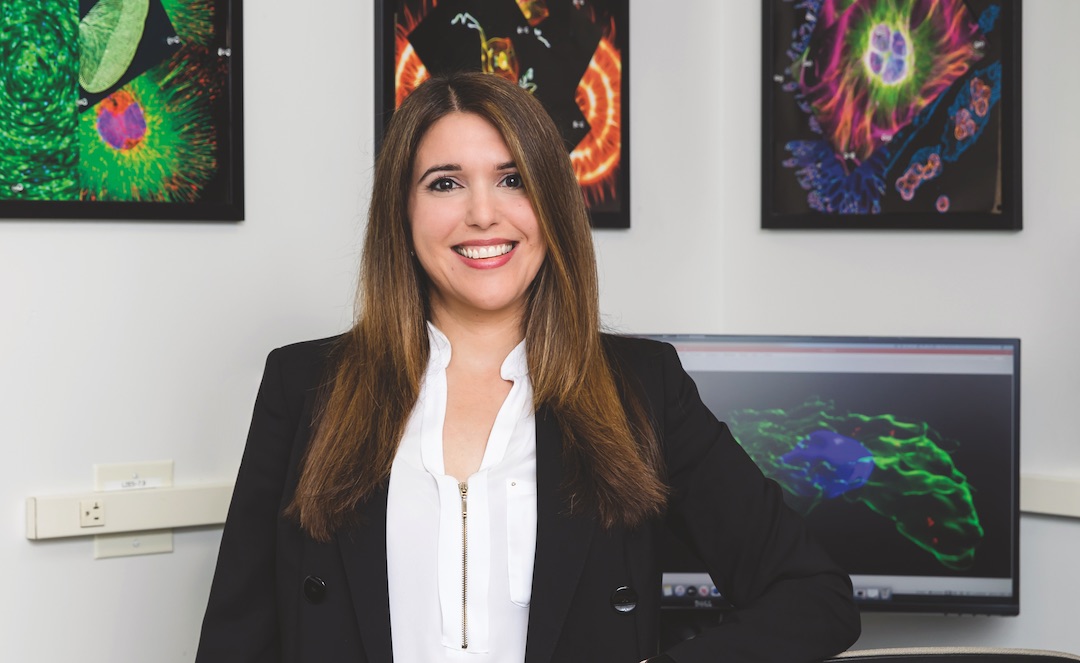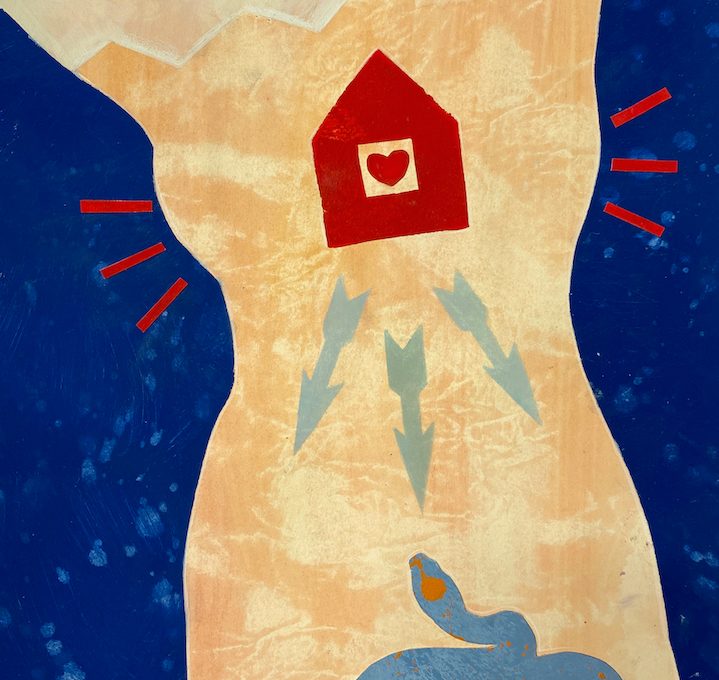When Erica Ollmann Saphire, Ph.D., was a kid, her house caught fire. It was the middle of the night in the tiny town of Lago Vista, Texas. There was no professional fire department, so the call was answered by volunteers: friends and neighbors.
“They got themselves out of bed at 3 a.m. and, at risk to themselves, fought that fire,” says Dr. Saphire.
Dr. Saphire’s family never forgot. “That volunteer fire department had no budget, so whenever they needed a new truck or a new hose, we had to raise the money ourselves,” Dr. Saphire recalls. “And every year at the annual barbecue, in recognition for what they did for us, my family was on that line serving the brisket, the cole slaw, the potatoes.”
See a problem, take action. That’s how she was raised.
“You build a community together. You do for others what needs to be done,” she says.
As the new President and CEO of La Jolla Institute for Immunology (LJI), Dr. Saphire aims to bring together the best researchers to address the biggest question out there: Why does a person get sick?
A person’s immune system may be as unique as their fingerprint. The COVID-19 pandemic taught all of us that lesson. For Dr. Saphire, the next decade of immunology is about figuring out the power of these individual differences.
“La Jolla Institute has the best minds in the world for untangling that complexity, and there are now better tools than we ever had before,” says Dr. Saphire.
Dr. Saphire’s own work has revealed the inner workings of devastating viruses such as Ebola, Lassa, measles, and SARS-CoV-2. She’s also well known for turning rival laboratories into close collaborators.
In 2014, as the Ebola virus took lives across West Africa, Dr. Saphire rallied 43 previously competing laboratories from five continents to come together, rethink a fragmentary research pipeline, and accelerate promising human antibodies against the disease. Instead of accepting the delays and gaps, Dr. Saphire united researchers into the Viral Hemorrhagic Fever Immunotherapeutic Consortium, and found ways to protect individual interests while developing the data and understanding they all needed to move forward.
“There are lots of problems that are too big for one lab and one tool to solve alone,” says Dr. Saphire. “The only way forward is to build structures and systems that allow us to pool resources.”
So it made sense that when the COVID-19 pandemic struck, the Bill & Melinda Gates Foundation sought Dr. Saphire’s expertise in building a virus-fighting team. Dr. Saphire now helms The Coronavirus Immunotherapy Consortium, called CoVIC, a global collaboration that brings academic, non-profit, and commercial laboratories together to develop the best antibody therapeutics against COVID-19.
“A pandemic brings out the best in some and the worst in others,” says Dr. Saphire. “You find where you have clear thinkers. You put your resources behind them and empower them to make the right decisions.”
Dr. Saphire earned her Ph.D. from Scripps Research in 2000. She stayed at Scripps Research to open her own lab and swiftly advanced to the position of full professor.
In 2019, the lab moved to LJI and established the Institute as a leader in cryo-electron microscopy, an imaging technique that can reveal how human cells and pathogens interact.
Many of her lab members have worked with her for years. They’ve raised their children together and published in top journals together. The lab is built on trust, not competition. “I give them the resources they need, and I get out of their way,” says Dr. Saphire. “I understand that if they have boots on the ground and hands in the research, they see things that I don’t.”
Dr. Saphire’s honors include the Presidential Early Career Award in Science and Engineering, an Investigator in the Pathogenesis for Infectious Disease Award from the Burroughs Wellcome Fund, a Mercator Award from Deutsche Forschungsgemeinschaft, a Fulbright Global Scholar fellowship from the U.S. Department of State, a scientific leadership award from the Global Virus Network, and the 2021 Scientist of the Year Award from ARCS Foundation – San Diego.
Dr. Saphire’s field requires persistence and patience. She is an expert in stabilizing viral proteins and capturing their structures through high-resolution imaging. These images work like blueprints of a virus and can reveal where the virus is vulnerable to human antibodies.
Until recently, the best way to get a clear image of a viral protein was to use a technique called x-ray crystallography. Although the images from x-ray crystallography are incredibly useful, the process of getting the images is grueling. It might take thousands of attempts before a scientist can prompt viral proteins to align and form a crystal.
In 2017, Saphire Lab member and LJI Instructor Kathryn Hastie, Ph.D., achieved the feat of determining the structure of Lassa’s outer shell protein, called the glycoprotein, together with a human antibody. The study, published as the cover story in Science, took 10 years.
“You just need the right kind of person with the right kind of tools to stick with it,” says Dr. Saphire. “It takes a person with tenacity.”
Dr. Saphire has a few scars—mostly from playing rugby. She helped start a women’s rugby team at her Texas university. They had seen the men playing and thought it looked like fun.
A rugby team wins possession of the ball as a unit called a “scrum.” Dr. Saphire is tall, so she played in the second row of the scrum, using leverage to hold ground or propel the group forward.
“I liked that there was a position for every skill and every body. Me, I was just muscle,” says Dr. Saphire.
Her job was to push the offensive players forward while using her entire body to keep the other team from getting too close. “We would use electrical tape to pin our ears down so they wouldn’t tear in the scrum,” says Dr. Saphire. “I’m very pleased I have all my teeth and both ears.”
Dr. Saphire stuck with rugby, and then played for the Bay Area Shehawks, the national champions at the time. She went on to play for two leading West Coast teams and also managed the United States Eagles.
“You can’t get rugby players down,” says Dr. Saphire. “If it’s 40 degrees and raining, and the field is full of mud, they start singing a song.”
Dr. Saphire had two herniated disks from playing rugby. But it was worth it, she says.
Dr. Saphire’s drive is also born of loss. As she was earning her Ph.D., her grandfather lay dying of colon and lung cancer. “I felt powerless,” she says.
“At the time, the doctors had nothing else to offer him and no explanation why a nonsmoker would develop tumors in his lungs. That inspired a career in research. I wanted to put something in the hands of those doctors so that someone else wouldn’t lose family member like that.”
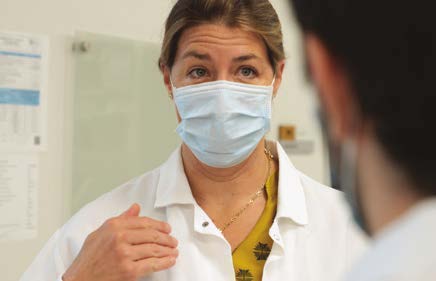
Since then, Dr. Saphire has taken on every project she can to strengthen her work and research around the globe. She gets up early to take conference calls with the World Health Organization. She entered an MBA program while running her lab. She recently launched a new project to understand retroviral causes of cancers and autoimmunity.
Her work has saved lives—and yet the human body still betrays.
A few years ago, Dr. Saphire met a San Diego couple who helped Dr. Saphire purchase a piece of equipment that her lab desperately needed to develop a rapid Ebola test. “Ebola at the start can look like food poisoning or malaria,” says Dr. Saphire. “The test, with rapid lines like a pregnancy test, gave doctors a way to know who has Ebola and who doesn’t have Ebola, so you don’t put the wrong patient in the Ebola ward or inadvertently release an Ebola patient to infect others.”
That gift saved thousands of lives in West Africa, according to a report from Doctors Without Borders. A friendship grew between Dr. Saphire and the family. One of them in particular became Dr. Saphire’s mentor and sounding board.
“He totally got it,” says Dr. Saphire. “He was a good man. He used his good fortune to propel other people and their lives and discoveries.”
In April 2021, he died of bile duct cancer. “There was a revolving door of good friends coming to say goodbye at the end,” Dr. Saphire says. “It’s not right that we don’t know why he got it, and it’s not right that we couldn’t do anything about it. We just had to say goodbye to a great human.
“There is a reason why that cell turned into cancer. It’s not an unexplainable event,” says Saphire. “There is a scientifically explainable reason, and we can study those reasons in a way that we couldn’t just ten years ago.”
“Why do some people get sick while others don’t?” asks Dr. Saphire. “Why does a person’s immune system turn against them and cause autoimmunity? Why does one person get diabetes when their twin doesn’t? The genes are the same, the environment is the same.”
At LJI, scientists are working to demystify the immune system. Flow cytometry specialists analyze cell populations. The imaging core is down the hall from the bioinformatics team. The Institute excels in microscopy, disease model development, antibody discovery, and database design. Sequencing experts shed light on immune cells and viral threats—they can even track gene expression at different points in an infection.
“La Jolla Institute has the brainpower, the tools, and the technology to address that question: Why do we get sick?” says Dr. Saphire. “If we understand the why, then we can find the markers to arrest it, the drugs to stop it, and the vaccine to prevent it.”
Dr. Saphire knows how to unite people, and she knows how to get people what they need. Through pandemics. Through the decades. Through the rain and mud.


